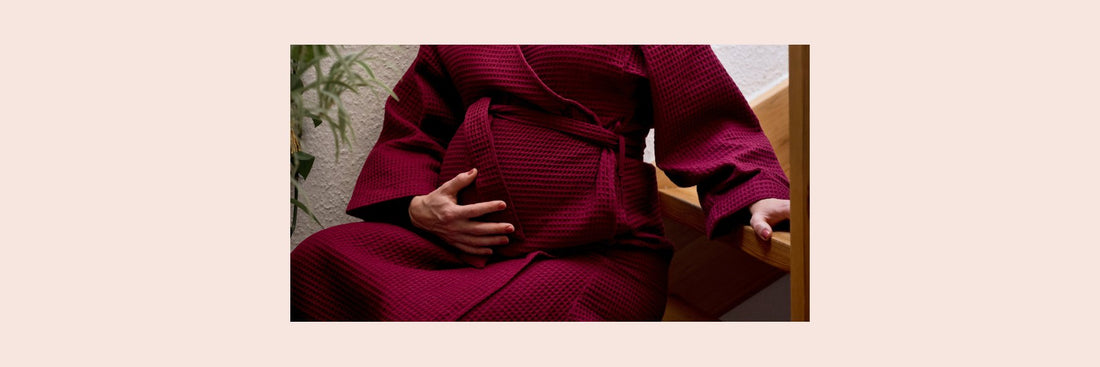Pregnancy is obviously a time when the body undergoes rapid changes. That often requires adjusting the clothes you are wearing so that they fit your growing belly.
Usually around the 15th and 16th week of pregnancy, when the belly is showing and the jeans are getting too tight, you start looking for something suitable - and reluctantly so. Because you don't want to invest in expensive clothes that you'll only wear for a few months and then no more. But who knows what your life will be like after the birth?
It is important that you have the right clothes for this time in your life. Here's an entire article on why you should buy maternity clothes. In summary, having comfortable clothing that doesn't restrict your movement or body is an act of self-care. If you invest in a dress or a top during this time, you should also think about the next phase of your life, namely the time after childbirth.
While pregnancy changes your body, having a baby also changes your lifestyle. After giving birth, the way you dress also changes. This is because the new lifestyle brings new needs.
If you decide to breastfeed, you need to have your breasts close at hand at all times.
You will be covered in a variety of different substances produced by your baby.
Later, the food your baby is eating will be all over you.
You will bring home kilos of sand from the playground.
You will be too tired to think about your styling and you will make more than questionable fashion decisions.
Here are some tips on what to look out for so that the clothes you buy during pregnancy don't just serve you for a few months, but suit your lifestyle for many years to come:
1. The right size.
Choosing the right size during pregnancy is very difficult. You're not sure about anything anymore. What size are you at the moment? What height will you be in the third trimester? How will your body change after pregnancy and childbirth? And how long will it take for him to find himself again? That's why it's best for you to buy plus-size clothing for this stage of your life. First, they fit both pregnant and postpartum tummies and will still look good once you've reached your fitness goals. Also, sizing is easy. At Wolf Mothers we combine sizes like S/M or L/XL. So if you wore an S or M before pregnancy, an S/M will also fit your bump. And if you feel like M/L - so you're not quite sure yet, it's always worth contacting us and just asking!
2. Nursing-friendly clothing.
While most typical maternity dresses are breastfeeding friendly, this is not always the case. Maternity wear often does not offer an easy way to breastfeed. If you choose to breastfeed your baby, you will most likely breastfeed for a while. The WHO (World Health Organization) recommends exclusive breastfeeding for six months and then until the second year of life. When buying a top that covers your stomach or a nice summer dress, make sure that you have easy access to your breasts later. One possibility is strategically placed zippers or that you can unbutton the top. My personal favorites are wrap dresses that you can easily unfold and fold back once the child has finished eating.
3. Stretch it out.
Maternity fashion is tailored for a growing bump. But when the belly is gone, she doesn't look quite as chic anymore. Also, tight fabrics worn during pregnancy are stretched and won't come back. While super-tight dresses look great during pregnancy, you'll likely never be able to wear them again after you give birth. Look for something loose that will hug your tummy nicely but won't lose its shape after the birth.
4. I will do laundry every day.
Basically, washing clothes is the worst thing you can do for them. However, what surprised me the most on my journey as a mother was the amount of laundry I did daily for my child and myself. With two toddlers, I'm usually completely dirty within 30-45 minutes of waking up! So when shopping for maternity clothes, make sure you read the care instructions. For one thing, garments that need to be hand washed or are delicate may not last long in this type of environment. Second, learn to read care labels; there you will find a lot of information on how to make your clothes durable. And last but not least: If you can hang your clothes to dry, you usually don't need to iron them.
5. Safety first.
Especially in the first few weeks of life, a baby's skin is very sensitive and can be easily irritated. Above all, artificial materials, which mostly consist of polymers, are not always pleasant and, above all, not safe for the delicate baby skin. And your baby is very close to your clothes. In fact, your offspring have much more contact with your clothes than with your skin. That is why it is very important to pay attention to certificates. Oeko-Tex 100 is the only certificate that confirms that textiles are safe for babies' and mothers' skin.Last but not least! Remember that fashion is meant to be a form of service and it is meant to serve you. Don't force yourself to fit into your old clothes; don't compare yourself to your friends and family; nor do you compare one pregnancy to another. Each time it's a different experience, and each time your body and life will change in a different way. And wearing things you're comfortable in is self-care!
Wolf Mothers was founded to create postpartum fashion, designed and tested by a mother of two. Look at it!

